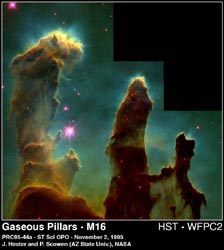
Click on the image for poster versionEerie, dramatic pictures from the Hubble telescope show newborn stars emerging from "eggs"—not the barnyard variety—but rather, dense, compact pockets of interstellar gas called evaporating gaseous globules (EGGs). Hubble found the "EGGs," appropriately enough, in the Eagle nebula, a nearby star-forming region 7,000 light-years from Earth in the constellation Serpens.
These striking pictures resolve the EGGs at the tip of finger-like features protruding from monstrous columns of cold gas and dust in the Eagle Nebula (also called M16). The columns—dubbed "elephant trunks"—protrude from the wall of a vast cloud of molecular hydrogen, like stalagmites rising above the floor of a cavern. Inside the gaseous towers, which are light-years long, the interstellar gas is dense enough to collapse under its own weight, forming young stars that continue to grow as they accumulate more and more mass from their surroundings.
This image was taken on April 1, 1995 with the Hubble Space Telescope Wide Field and Planetary Camera 2. The color image is constructed from three separate images taken in the light of emission from different types of atoms. Red shows emission from singly-ionized sulfur atoms. Green shows emission from hydrogen. Blue shows light emitted by doubly- ionized oxygen atoms.

